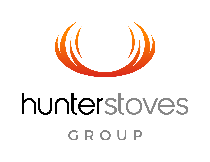Hunter Stoves Group recommend that only wood logs (with a moisture content of less than 20%) and anthracite, or a manufactured briquette smokeless fuel suitable for closed door appliances are used.
Burning wet or unseasoned wood will create excess smoke emissions, tar deposits in the stove and chimney and will not produce a satisfactory heat output.
Only authorised fuels may be used in UK smoke control areas. A list of authorised fuels can be found at https://www.gov.uk/smoke-control-area-rules.
DO NOT BURN BITUMINOUS COAL, PETRO-COKE, OTHER PETROLEUM BASED FUELS OR TREATED WOOD SUCH AS PALLETS AS THIS WILL CAUSE DAMAGE TO THE APPLIANCE.
Hardwood has a higher heat content than softwood due to it having denser properties. Therefore, you would need double the amount of softwood to produce the same amount of heat as hardwood. Some softwoods produce a larger amount of smoke so talk to your fuel supplier for their advise. Harwoods burn for a longer period of time which means you do not have to top up as much. Please see a list of wood and its qualities;
Wood types suitable for closed appliances and open fires -
Ash, Alder, Apple, Beech, Birch, Blackthorn, Elm, Eucalyptus, Hawthorn, Hazel, Holly, Hornbeam, Maple, Oak, Pear, Rowan, Sycamore, Wild Cherry, Willow,
Types of wood prone to spitting and crackling -
These woods are only suitable for closed appliances. Softwoods tend to pop and spit more because of the pockets of moisture and sap contained within the wood.
Cedar, Douglas Fir, Horse Chestnut, Larch, Plane, Sweet Chestnut, Willow.
Other wood types -
Elder - Produces a thick acrid smoke
Lime - A low quality fuel
Pine species (including Leylandi) can form oily soot deposits in the chimney
Do not use any firewood that is contaminated. For example pallet wood is normally treated and this can produce harmful gas emissions which can affect your health. Contaminated wood can also cause damage to the appliance and flue/chimney.
Moisture;
The moisture content in trees varies considerably with those felled in the summer having up to 65% of the weight of the timber as water.
Tree felling carries on all year round but ideally should be done in the winter and preferably before the end of March (some species of trees felled in winder are ready to use the following winter). The moisture content of the wood that you use should be no more than 20%. The logs can also have their moisture content reduced by kiln drying.
Log Storage;
When looking to purchase a store for your logs please allow a minimum of 1.5m3 to accommodate 1m3 and the store should be well ventilated on at least two sides. If you are looking to purchase unseasoned (wet/green) wood a much larger storage capacity is required.
Logs should be no more than 10cm thick and cut to the required length for your appliance (shown in the instruction manual of each stove). Split logs are preferable to round logs. Seasoned logs will have bark that comes away easily. The moisture content of the wood does have an effect on the heat output of an appliance as no heat will be produced until the moisture is burnt off. You would require approximately three times as many unseasoned logs as seasoned or kiln dried logs to produce heat.
SOLID FUEL
Smokeless fuel has a higher heat content and a sustained heat which can help you to burn overnight (also dependent on other factors). If you are looking to burn both fuel types then it is best to start with logs and once the fire is established add mineral fuel.
Do not add logs to a fire that has been burning overnight or after slow burning. However, smokeless fuel can be added and then the air reduced after fuel is glowing.
DO NOT BURN BITUMINOUS COAL, PETRO-COKE, OTHER PETROLEUM BASED FUELS AS THIS WILL DAMAGE YOUR APPLIANCE AND INVALIDATE YOUR WARRANTY.
Suitable Solid Mineral Fuels For Closed Appliances
Homefire - Hexagonal briquette. Lights easily and burns with a long, glowing flame.
Supertherm - Smokeless ovoid's.
Homefire Ovals - Clean-burning ovoid that is distinguished by two parallel lines across the middle. Has a high radiant heat output which allows for long refuelling intervals due to slow burning rate.
Coalite Newflame - Pillow shaped ovoid, smokeless and easy to light, long burn duration. Produces minimal waste and clinker.
Phurnacite - Is a clean and slow burning premium briquettes. Distinguished by two longitudinal parallel lines.
Ancit - This is a slow burning smokeless briquette with a high heat output.
Taybrite (Surefire) - Easy to light and clean burning. Provides a long lasting controllable heat.
Maxibrite - A smokeless ovoid with an, M marking. Has a good heat output with minimum waste and clinkers and is odour free.
Pureheat, Newheat and Excel are also suitable fuels to use.
Safety Advice - Solid Fuel
Ventilation
Ensure that there is adequate ventilation for your appliance and that the vents do not become blocked or covered. Ventilation varies between stoves and information can be found within the appliance instructions.
Maintenance
Ashpans should be emptied and checked every day. An over-full ashpan can cause damage to the grate and will also stifle the air flow needed to burn the fuel.
The throat plate/baffle must be removed and cleaned every month to stop build up of ash and tar products.
Chimneys should be swept at least twice per year. With new installations if an appliance has been placed in a fireplace that was previously used by an open fire then the flue should be swept after 6 months.
Fuel
Please purchase your fuel from an approved coal merchant. A list of which can be found on the following websites -
www.solidfuel.co.uk
www.hetas.co.uk/find-fuels
